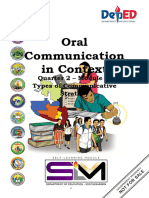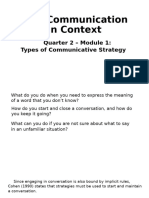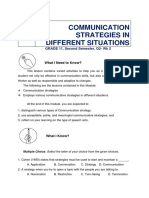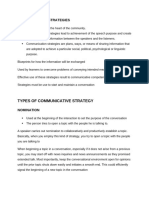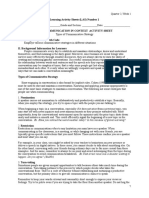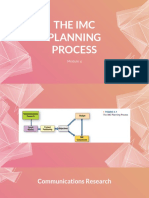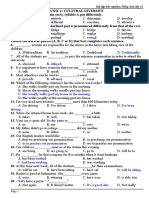#Throwback: Directions: Each Problem Presents A Short Dialogue. You Must Identify Which Maxim Is Being Used or Violated
#Throwback: Directions: Each Problem Presents A Short Dialogue. You Must Identify Which Maxim Is Being Used or Violated
Uploaded by
MauiCopyright:
Available Formats
#Throwback: Directions: Each Problem Presents A Short Dialogue. You Must Identify Which Maxim Is Being Used or Violated
#Throwback: Directions: Each Problem Presents A Short Dialogue. You Must Identify Which Maxim Is Being Used or Violated
Uploaded by
MauiOriginal Title
Copyright
Available Formats
Share this document
Did you find this document useful?
Is this content inappropriate?
Copyright:
Available Formats
#Throwback: Directions: Each Problem Presents A Short Dialogue. You Must Identify Which Maxim Is Being Used or Violated
#Throwback: Directions: Each Problem Presents A Short Dialogue. You Must Identify Which Maxim Is Being Used or Violated
Uploaded by
MauiCopyright:
Available Formats
#throwback
Let’s Do This:
Directions: Each problem presents a short dialogue. You must identify
which maxim is being used or violated.
1) John: Where have you been? I searched
everywhere for you during the past three months!
Mike: I wasn’t around. So, what’s the big deal?
2) Teacher: Why didn’t you do your homework?
Student: May I go and get some water? I’m so
thirsty.
#throwback
3) Sarah: Did you enjoy the party last night?
Anna: There was plenty of oriental food on the table, lots of
flowers all over the place, people hanging around
chatting with each other…
4) Bob: What were you and Anna talking about? You were
looking all the time!
Marry: Oh, well… why don’t we go get something to drink?
5) Wow! You’re such a punctual fellow! Welcome to the class.
Student: Sorry sir! It won’t happen again.
Employing Various Communicative Strategies
in Different Situations
EXPECTATION
You will be able to:
1. define different communicative
strategies;
2. distinguish the different communicative
strategies; and
3. employ communicative strategies in
different situations.
LET’S REVIEW
Read the definitions presented and identify which
communicative strategy is being defined. Your choices are:
Nomination Restriction Turn-taking
1. Any limitation you have as a speaker
2. The process by which people decide who takes the
conversational floor
3. Done to collaboratively and productively open or establish a
topic
4. The primary idea is to give all communicators a chance to
speak.
5. There are specific and implied instructions that limit what you
can say and how you can communicate in different situations.
LET’S REVIEW
Read the definitions presented and identify which communicative
strategy is being defined.
Your choices are:
Topic Control Topic Shifting
1. It covers how procedural formality and informality affects the
development of topics in a conversation.
2. It develops a topic by avoiding unnecessary interruptions and topic
shifts.
3. It involves moving from one topic to another.
4. This is simply a question-answer formula that moves the discussion
forward.
5. It is where one part of a conversation ends and another part begins.
LET’S TALK
NOMINATION
A speaker employs nomination to
collaboratively and productively open or
establish a topic. When this strategy is used,
the speaker opens a topic with the people
they are talking to. Ideally, the presented
topic is clear, truthful, and relevant.
LET’S TALK
Formal Situations:
In a meeting, the agenda is given for the
participants to discuss.
“Today we will talk about…”
In class, a teacher will start the discussion
about a topic.
“Our lesson for today is…”
LET’S TALK
Informal Situations:
Every time you start a conversation with a family or friend.
“Hey, have you heard?”
“Listen, I have something to share.”
“Can I ask you something?”
“How are you? I haven’t heard from you for a while.”
A quick conversation with a stranger may also be
established.
“Excuse me, can you tell me how to get to the library?”
“I’m here to share the message of God, would you care to
give me a few
minutes to tell you about His promise?”
LET’S TALK
RESTRICTION
A restriction in communication refers to any
limitation one may have as
a speaker, constraining the response or reaction
within a set of categories. This
strategy constrains or restricts the response of
the other person involved in the
communication situation. The receiver is
encouraged to respond only within a
set of categories, instructions, or preference that
is made by the sender.
LET’S TALK
Formal Situations:
Restriction can be shown when one person controls
the topics to be
discussed and sets boundaries in the communication
situation.
“Leave the questions for later, let us listen for now.”
“Please don’t ask about sensitive topics.”
“I know you’re emotional, but please maintain
respect as you speak.”
“Only discuss how your group can improve the 2nd
chapter of your
research paper”
LET’S TALK
Informal Situations:
When talking with family or friends, one
can set the rules.
“Please don’t shout. Let’s talk this through.”
“Just be honest and don’t sugarcoat
anything.”
“Just answer with a Yes or a No.”
LET’S TALK
TURN-TAKING
The communicative strategy turn-taking is the process by which
people
decide who takes the conversational floor. There is a code of
behavior behind
establishing and sustaining a productive conversation, but the
primary idea is
to give all communicators a chance to speak. Someone involved in the
communication situation must be able to recognize when and how to
speak.
Knowing when to speak depends on watching out for verbal and
nonverbal cues
that signal the next speaker that the previous speaker has finished, or
that the
subject being discussed is done and a new topic can be introduced.
LET’S TALK
Formal Situations:
In meetings, people could take turns sharing
their ideas.
“Who wants to share their thoughts next?”
“I’m done, go ahead.”
“I’ll let you finish, let me explain it after.”
“Without further ado, let’s now listen to…”
There will be times when no words are
necessary, just the gestures and
expression can signal another person to speak.
LET’S TALK
Informal Situations:
In casual conversations.
“What do you think? What are your
thoughts about it?”
“Tell me about it, I’ll listen.”
“Guys, let’s hear what she’s about to say.”
IDENTIFY THE COMMUNICATIVE
STRATEGY
IDENTIFY THE COMMUNICATIVE
STRATEGY
IDENTIFY THE COMMUNICATIVE
STRATEGY
You might also like
- Types of Communicative StrategiesDocument3 pagesTypes of Communicative Strategiesshaira mae licardo83% (6)
- History of PhlebotomyDocument46 pagesHistory of PhlebotomyDorothy AtilanoNo ratings yet
- Frans KrugerDocument18 pagesFrans KrugerVira LledoNo ratings yet
- Penghantar Komunikasi Bab 1Document3 pagesPenghantar Komunikasi Bab 1izham razakNo ratings yet
- Oral ComDocument31 pagesOral ComMaca UyagNo ratings yet
- Communicative StrategyDocument2 pagesCommunicative StrategyJulieSanchezErsando100% (1)
- LESSON 10. Types of Communicative StrategyDocument32 pagesLESSON 10. Types of Communicative Strategyguerrerozyrene220100285No ratings yet
- Second Quarter Oral Com Topics For StudentsDocument11 pagesSecond Quarter Oral Com Topics For StudentsZion ZionNo ratings yet
- communicative-strategyDocument70 pagescommunicative-strategyAesha BalayonNo ratings yet
- Types of Communicativ E StrategiesDocument12 pagesTypes of Communicativ E StrategiesRuth Andre Bandiola100% (1)
- Lesson5 CommunicativestrategyDocument20 pagesLesson5 CommunicativestrategyRojenald Cruz100% (1)
- Oral-Communications Q2 Module-1Document10 pagesOral-Communications Q2 Module-1Lee RichardNo ratings yet
- Communicative Strategies Are Techniques On How To Deal With Difficulties Encountered When CommunicatingDocument5 pagesCommunicative Strategies Are Techniques On How To Deal With Difficulties Encountered When CommunicatingPaul Vincent JimenezNo ratings yet
- Com StratDocument29 pagesCom Stratsecretloveu17No ratings yet
- Types of Communicative StrategyDocument3 pagesTypes of Communicative StrategyCyrille GustiloNo ratings yet
- Types of Communicative Strategy: Prepared By:david Jhonson M. Basnillo and John Marco Y. Sarol Grade Xi - Stem 2 StudentsDocument10 pagesTypes of Communicative Strategy: Prepared By:david Jhonson M. Basnillo and John Marco Y. Sarol Grade Xi - Stem 2 StudentsDavid Jhonson BasnilloNo ratings yet
- Types of Communicative Strategy 1. NominationDocument3 pagesTypes of Communicative Strategy 1. NominationRengie GaloNo ratings yet
- Module 8Document4 pagesModule 8Darlene Dale LapingNo ratings yet
- q2 Oral Com - Lesson 1Document13 pagesq2 Oral Com - Lesson 1RUBY MAE ASMOLONo ratings yet
- Rogationist College Senior High School Department School Year 2017-2018Document4 pagesRogationist College Senior High School Department School Year 2017-2018Mark DimailigNo ratings yet
- Oral Comm. Lesson 1 Q2Document9 pagesOral Comm. Lesson 1 Q2Beth RoceroNo ratings yet
- Communicative StrategyDocument14 pagesCommunicative StrategyMelissa R.Bartolay100% (2)
- Rogationist College Senior High School Department School Year 2017-2018Document4 pagesRogationist College Senior High School Department School Year 2017-2018gaming accountNo ratings yet
- 2ND Quarter Module Oral Communication 11Document65 pages2ND Quarter Module Oral Communication 11Kem KemNo ratings yet
- Types of Commungroup8-WPS OfficeDocument23 pagesTypes of Commungroup8-WPS OfficeJames Lister DoydoyNo ratings yet
- CO 1 Oral Com 2021Document21 pagesCO 1 Oral Com 2021Jesh Manansala-DesavilleNo ratings yet
- Communicative StrategiesDocument36 pagesCommunicative Strategiesyurisg2798No ratings yet
- Name: Grade Level: Section: Date:: 3. Applies Conversational and Politeness Norms For Effective CommunicationDocument11 pagesName: Grade Level: Section: Date:: 3. Applies Conversational and Politeness Norms For Effective CommunicationG'day MateNo ratings yet
- Communicative StrategiesDocument4 pagesCommunicative Strategieshezekiah minNo ratings yet
- Communication StrategiesDocument9 pagesCommunication Strategiesambionred109319No ratings yet
- Communication Strategies 1Document3 pagesCommunication Strategies 1Jay Villanueva100% (1)
- Types of Speech Style and Communicative StrategyDocument5 pagesTypes of Speech Style and Communicative StrategyGennelyn Grace Penaredondo100% (2)
- Types of Communicative StrategyDocument10 pagesTypes of Communicative StrategyAriane Grace LopezNo ratings yet
- Types of Communication StrategyDocument4 pagesTypes of Communication StrategyYuna CapellanNo ratings yet
- Oral-Com Q2 Week-1Document4 pagesOral-Com Q2 Week-1Auda SpringNo ratings yet
- 8.-COMMUNICATIVE-STRATEGIESDocument18 pages8.-COMMUNICATIVE-STRATEGIESsagumjurienNo ratings yet
- Types of Communicative StrategyDocument46 pagesTypes of Communicative StrategyMyra Bolinas100% (1)
- Types of Communicative StrategyDocument30 pagesTypes of Communicative StrategycarumbamiashellalNo ratings yet
- Definition of Speech ActsDocument7 pagesDefinition of Speech ActsWiljon Bermas Odi100% (1)
- CommunicativestrategyDocument18 pagesCommunicativestrategyJennyfer Alcesto Bullecer50% (2)
- CommunicativestrategyDocument18 pagesCommunicativestrategyJennyfer Alcesto Bullecer100% (1)
- Co 1 DesavilleDocument22 pagesCo 1 DesavilleJesh Manansala-DesavilleNo ratings yet
- Oral Communication in Context: Self-Learning ModulesDocument12 pagesOral Communication in Context: Self-Learning ModulesJennie KimNo ratings yet
- Types Of: StrategiesDocument16 pagesTypes Of: StrategiesClaire Antonette B. Barrios100% (1)
- Types of Communicative StrategiesDocument16 pagesTypes of Communicative StrategiesDennis Laurel100% (1)
- ORALCOM FINAL1stSem-1Document41 pagesORALCOM FINAL1stSem-1Kyle LeysonNo ratings yet
- Socratic Seminar InfoDocument2 pagesSocratic Seminar Infoapi-213424902No ratings yet
- 2nd Quarter Lesson 2Document6 pages2nd Quarter Lesson 2Charleston RoaNo ratings yet
- Pre-reading stage: Мethodological justificationDocument5 pagesPre-reading stage: Мethodological justificationNadya NadyaNo ratings yet
- OBJ ECT IvesDocument28 pagesOBJ ECT IvesJames BunglayNo ratings yet
- Communicative StrategyDocument14 pagesCommunicative Strategygillian kharllNo ratings yet
- Oral Communication 1Document95 pagesOral Communication 1Fraire AcupanNo ratings yet
- TYPE OF COMMUNICATIVE STRATEGYDocument12 pagesTYPE OF COMMUNICATIVE STRATEGYlezlie danoNo ratings yet
- Stem 11 Persistence ModulesDocument33 pagesStem 11 Persistence Moduleshannamaemanaog4No ratings yet
- M8 Process of CommunicationDocument10 pagesM8 Process of CommunicationKristine BarrantesNo ratings yet
- Types of Communicative StrategiesDocument23 pagesTypes of Communicative StrategiesLolita QueroNo ratings yet
- Q2 01 - Communicative Strategies PDFDocument55 pagesQ2 01 - Communicative Strategies PDFRoanne Matel DepEdNo ratings yet
- Lesson 2 Commmunicative StrategiesDocument35 pagesLesson 2 Commmunicative StrategiescarlbitabaraNo ratings yet
- Module 6 Types of Communicative Strategies 1Document7 pagesModule 6 Types of Communicative Strategies 1Christian MonterroyoNo ratings yet
- TYPES O.-Types of Communication Strategies II-02Document12 pagesTYPES O.-Types of Communication Strategies II-02Darlene JovenNo ratings yet
- TYPES of Communication STrategyDocument21 pagesTYPES of Communication STrategyReny MalayaoNo ratings yet
- OralCom Prefinals ReviewerDocument7 pagesOralCom Prefinals ReviewerPedro HampaslupaNo ratings yet
- Great Debates: 24 of the Most Important Questions in Modern Society for Teachers of ESL and EAPFrom EverandGreat Debates: 24 of the Most Important Questions in Modern Society for Teachers of ESL and EAPNo ratings yet
- Speech ActsDocument2 pagesSpeech ActsMauiNo ratings yet
- Philippine Folk Dance: With Spanish InfluenceDocument30 pagesPhilippine Folk Dance: With Spanish InfluenceMauiNo ratings yet
- Post Test 3RD Quarter Envi - SciDocument3 pagesPost Test 3RD Quarter Envi - SciMaui100% (1)
- Week 1 Intro of BiotechnologyDocument31 pagesWeek 1 Intro of BiotechnologyMauiNo ratings yet
- REVISED MODULE 4th QUARTER ENVISCIDocument46 pagesREVISED MODULE 4th QUARTER ENVISCIMaui100% (1)
- Philippine Folk Dances With Spanish InfluenceDocument28 pagesPhilippine Folk Dances With Spanish InfluenceMauiNo ratings yet
- Calendar&Communication SivaDocument16 pagesCalendar&Communication SivaSivasundaram PalanisamyNo ratings yet
- Pca Ingles Primero Bgu 2024 - 2025Document16 pagesPca Ingles Primero Bgu 2024 - 2025Verónica SanmartínNo ratings yet
- Anna-Lysa Gayle's Updated ResumeDocument1 pageAnna-Lysa Gayle's Updated ResumeLysa GayleNo ratings yet
- Communication and Culture 1 and 2Document36 pagesCommunication and Culture 1 and 2Sam TabujaraNo ratings yet
- t1 Mid-Term Progress Reports 2020-2021 - 3f 1Document30 pagest1 Mid-Term Progress Reports 2020-2021 - 3f 1api-350645010No ratings yet
- Clínica Medicina DeporteDocument164 pagesClínica Medicina DeporteWalter PelaezNo ratings yet
- By The End of The Lesson Pupils Will Be Able To: Present and Practice Ilike/I Don't Like by The End of The Lesson Pupils Will Be Able Topractice Asking and Answering QuestionsDocument6 pagesBy The End of The Lesson Pupils Will Be Able To: Present and Practice Ilike/I Don't Like by The End of The Lesson Pupils Will Be Able Topractice Asking and Answering QuestionsAmandaCheahNo ratings yet
- ACTFL Proficiency Guidelines 2024Document56 pagesACTFL Proficiency Guidelines 2024darinka.duzicNo ratings yet
- Unit Test 2: Answer All Thirty Questions. There Is One Mark Per QuestionDocument3 pagesUnit Test 2: Answer All Thirty Questions. There Is One Mark Per QuestionЯрослав ЛиманскийNo ratings yet
- Teaching Leadership SurveyDocument1 pageTeaching Leadership SurveyMitsylene Powell-Richards100% (1)
- Learning and Evaluation SituationDocument54 pagesLearning and Evaluation Situationapi-385303128No ratings yet
- România: Ministry of National Education and Scientific ResearchDocument7 pagesRomânia: Ministry of National Education and Scientific ResearchAdi HazaparuNo ratings yet
- 4G Technology: January 2016Document5 pages4G Technology: January 2016Abhishek SrivastavaNo ratings yet
- Past PapersDocument13 pagesPast PapersdavidparkeNo ratings yet
- Module 6 Course Reflection PaperDocument2 pagesModule 6 Course Reflection Paperapi-564978867No ratings yet
- Vanessa Ingles Once 2020Document7 pagesVanessa Ingles Once 2020DEIBER YEISON TUNJANO BUITRAGONo ratings yet
- Republic of The Philippines Sorsogon State College Sorsogon City Campus Sorsogon CityDocument5 pagesRepublic of The Philippines Sorsogon State College Sorsogon City Campus Sorsogon CityJhon Dave Surbano100% (2)
- Test 1Document2 pagesTest 1Juliet Aylar Quisora100% (1)
- DLP 4th Quarter IndependentDocument4 pagesDLP 4th Quarter Independentnataniel borromeoNo ratings yet
- Case Analysis: Submitted By: Group 4 (Batch 2)Document6 pagesCase Analysis: Submitted By: Group 4 (Batch 2)Ayush MittalNo ratings yet
- Grade 7 DLL DressmakingWeek21Document3 pagesGrade 7 DLL DressmakingWeek21Noel Jose Malanum100% (1)
- The Imc Planning ProcessDocument35 pagesThe Imc Planning ProcessTRIXIA MAE B. ESPIRITUNo ratings yet
- Lesson Plan - EstimationDocument2 pagesLesson Plan - Estimationapi-376794758No ratings yet
- Nid, Haryana: by Hassan Jaseem KM S9, B.Arch. MKANEBCO17 14-12-2017Document12 pagesNid, Haryana: by Hassan Jaseem KM S9, B.Arch. MKANEBCO17 14-12-2017jazNo ratings yet
- 3.2 - Market Research - IGCSE AIDDocument5 pages3.2 - Market Research - IGCSE AIDManeeta KaurNo ratings yet
- 16 unit bài tập tiếng anhDocument48 pages16 unit bài tập tiếng anhPhương TrinhNo ratings yet
- Digital Marketing Proposal: TechnologiesDocument7 pagesDigital Marketing Proposal: TechnologiesBikash ChetryNo ratings yet











